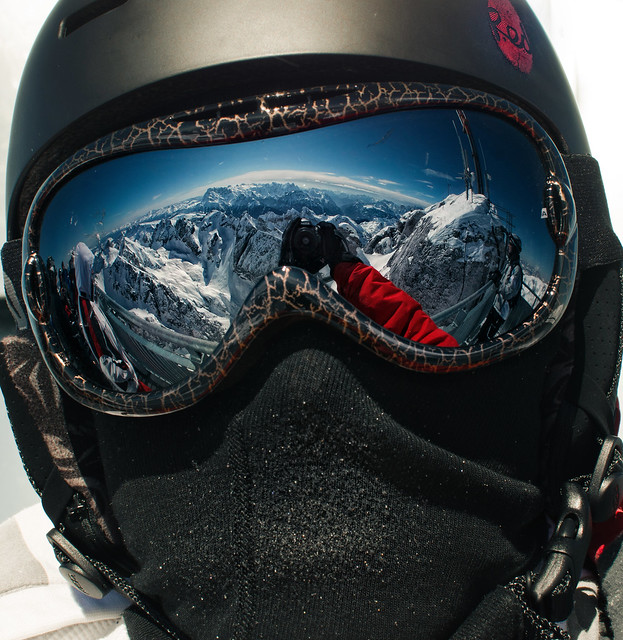
[Image by fullcex]
Just because there’s no snow somewhere doesn’t mean skiing isn’t possible. Far from it. Where there is imagination, there is possibility… as the following ways have proven:
1. Dry Ski Slopes
Also called artificial ski slopes, these are man-made ski surfaces that foster a similar level of exhilaration and flexibility when skied on as if one is skiing on snow. They are not ‘dry’ in the true sense of the word as the surfaces are moistened with lubricants to boost ski speed and to also prevent heat occurrence as a result of friction. More popular ski slope surfaces include:
2. Snowflex
Snowflex is the brainchild of UK-based Briton Engineering Developments Ltd. The material’s made of polymer, is shock absorbent and friction reductive. It also has cushioning for when falls occur and doesn’t have any holes or any bits sticking out that skiers could injure themselves on. Snowflex has been used to create several synthetic slopes including the Stade de glisse in Noeux-les-Mines (Northern France), Virginia Liberty University (called the Liberty Mountain Snowflex Centre) and Woodward Camp in Copper Mountain (Colorado).
3. Perma-snow
Created by Techmat 2000, it claims to be ideal for dry skiing (and snowboarding), is fall-safe, hole-free and doesn’t have any metals used on its surface (smoother – lessening the likelihood of injury). It’s been installed in places such as Alice Springs Golf Club in Usk, Monmouthshire and five John Nike Leisuresport Ski Centres across the UK.
4. Neveplast
Neveplast is more commonly used for set-ups of a temporary nature as it is flexible and module-based. The Italy-based company focuses some of its product attention towards alpine skiing, cross-country skiing and snowboarding activities. Neveplast boasts of having as close to a skiing feeling as you can get to actually being on real snow, thereby enhancing the skier’s level of grip and diminishing the need for him or her to use any lubrication when skiing. Its clients include Hillend Snowsports Centre (Scotland), SKI WARD ski resort (Massachusetts) as well as a number of advertising agencies.
5. Use of Ski Simulators
Ski simulators are used by skiers and snowboarders alike. They use it for training purposes, similar to how some pro runners use treadmills to train or rowers use rowing machines. The main advantage is these simulators can be used anywhere in the world, indoors or outdoors, snow or none at all.
There are some ski simulators that are also known as ski carpets or ski slope carpets. These appear to be accessible to skiers of all levels. The Slope Infinity Ski & Snowboard Training Centre in Hong Kong has a revolving carpet ski and is the largest of its kind. You use real skiing equipment and can adjust the speed at which the ski carpet turns.
6. Use of a Snowmaking Machine
This is the next best thing to Mother Nature producing her own snow. A snowmaking machine applies pressure to water and air and voila, you have your snow. It’s common for snowmaking machines to be used in:
Indoor ski slopes: the indoor temperature is kept at a certain level to ensure the production and maintenance of snow. In many ways, it’s similar to indoor ice skating where it mimics a naturally forming frozen lake or river. As long as snow can be produced, indoor skiing can take place, which means it can take place anytime during the year or throughout. Popular indoor ski slopes include the UK’s SnowDome in Tamworth/Staffordshire (170m in length), Ski Dubai in United Arab Emirates (400m), and Snow world in the Netherlands (for which there are two – one in Landgraaf (520m), the other in Zoetermeer (210m)).
Outdoor ski slopes: Used in some ski resorts where there’s already natural snow – the machines are used as a way of enhancing what’s already there. Useful in cases where there’s a snow shortage. Heavenly Mountain Resort (Nevada), for example, does that. Last year, it only opened 26 of the 97 ski trails it runs because the weather being warmer than usual meant there was a shortage of natural snow. They had to improvise with their machines (apparently has one of the largest snow-producing machines in the US).
Snowmaking machines are also used in quite a few other places including Mount Hotham in Australia and Smiggin Holes in New South Wales, Australia.
As you can see, it’s quite possible to still have a whale of a time skiing when there’s absolutely no snow in sight or when there doesn’t seem to be enough snow, or even without having to go outdoors. Thanks to a good measure of imagination, creativity and invention, whether through ski simulators, dry slopes or snowmaking machines, skiing can still be had and can be just as enjoyable.
This guest post was contributed by Peak Transfer.

Follow itravelnet.com